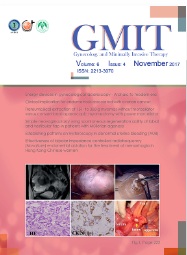Hnin Thazin Htut, Hsin‑Mei Liu, Chyi-Long Lee
Objective
This study aimed to demonstrate the anatomic marker in complete excision of endometriosis by a well‑expertised surgeon in laparoscopic management of severe deep infiltrating endometriosis (DIE).
Design
We demonstrate the surgical technique step by step. During this procedure, we use the effective bipolar to achieve hemostasis and create retroperitoneal spaces from the patient with severe dysmenorrhea and severe DIE (revised American Fertility Society classification Stage IV).[1,2]
Patient
The patient was a 43-year-old woman, G2P2, suffered from severe dysmenorrhea and diagnosed by ultrasonography with a 5.7 cm × 4.3 cm right endometrioma and deep infiltrating endometriosis.[3]
Interventions
Three-handed operative laparoscopy with the 10 mm umbilicus port was applied. Intraoperatively, in addition to the right endometrioma, DIE was observed at both uterosacral ligaments (USL) with partial obliteration of cul-de-sac. After lysis of intrapelvic adhesions, rupture and enucleation of the right endometrioma was done. Bilateral ureterolysis was performed after identifying retroperitoneal space [Figure 1a].[4] After dissection of the left pararectal space, excision of endometriotic lesions of the left USL was done [Figure 1b]. Prerectal space was dissected then. The pouch of Douglas was partially obliterated by adhesions, which was also lysed to correct her
pelvic anatomy as normal as possible [Figure 2a and b]
Results
The endometriotic lesions of the right USL were also excised.
Complete excision of endometriosis was achieved. The histopathology of all excised tissues was consistent with endometriosis. No adjuvant therapy was given for this patient. Her ultrasonography and CA-125 at 3 months postoperatively showed no recurrence of endometrioma and the patient has remained asymptomatic till date.
Conclusion
This case highlights that the gynecologist who performs laparoscopic excision of DIE should be well expertized and complete surgical excision during the first time. Identifying the retroperitoneal space and ureter and correcting pelvic anatomy are the keys of success in treating DIE patients.[5-7]
Gynecol Minim Invasive Ther. 2022 Feb 14;11(1):76-77. doi: 10.4103/GMIT.GMIT_26_21. PMID: 35310119; PMCID: PMC8926043.
This study aimed to demonstrate the anatomic marker in complete excision of endometriosis by a well‑expertised surgeon in laparoscopic management of severe deep infiltrating endometriosis (DIE).
Design
We demonstrate the surgical technique step by step. During this procedure, we use the effective bipolar to achieve hemostasis and create retroperitoneal spaces from the patient with severe dysmenorrhea and severe DIE (revised American Fertility Society classification Stage IV).[1,2]
Patient
The patient was a 43-year-old woman, G2P2, suffered from severe dysmenorrhea and diagnosed by ultrasonography with a 5.7 cm × 4.3 cm right endometrioma and deep infiltrating endometriosis.[3]
Interventions
Three-handed operative laparoscopy with the 10 mm umbilicus port was applied. Intraoperatively, in addition to the right endometrioma, DIE was observed at both uterosacral ligaments (USL) with partial obliteration of cul-de-sac. After lysis of intrapelvic adhesions, rupture and enucleation of the right endometrioma was done. Bilateral ureterolysis was performed after identifying retroperitoneal space [Figure 1a].[4] After dissection of the left pararectal space, excision of endometriotic lesions of the left USL was done [Figure 1b]. Prerectal space was dissected then. The pouch of Douglas was partially obliterated by adhesions, which was also lysed to correct her
pelvic anatomy as normal as possible [Figure 2a and b]
Results
The endometriotic lesions of the right USL were also excised.
Complete excision of endometriosis was achieved. The histopathology of all excised tissues was consistent with endometriosis. No adjuvant therapy was given for this patient. Her ultrasonography and CA-125 at 3 months postoperatively showed no recurrence of endometrioma and the patient has remained asymptomatic till date.
Conclusion
This case highlights that the gynecologist who performs laparoscopic excision of DIE should be well expertized and complete surgical excision during the first time. Identifying the retroperitoneal space and ureter and correcting pelvic anatomy are the keys of success in treating DIE patients.[5-7]
Gynecol Minim Invasive Ther. 2022 Feb 14;11(1):76-77. doi: 10.4103/GMIT.GMIT_26_21. PMID: 35310119; PMCID: PMC8926043.




